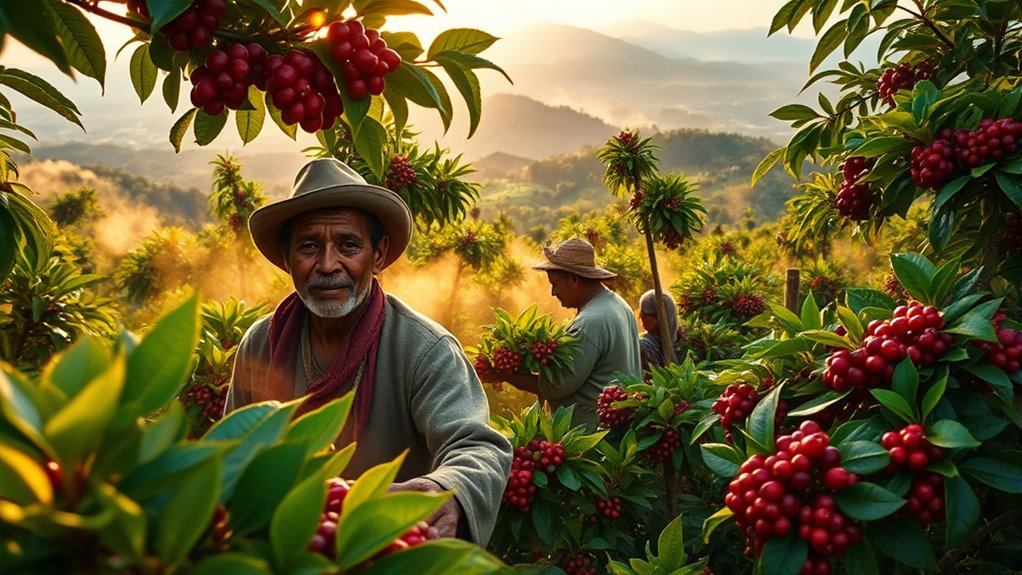Legend has it that Ethiopian goat herder Kaldi discovered coffee after seeing goats energized by berries from a shrub. From Ethiopia, coffee traveled to Yemen, where Sufi mystics used it to stay alert. It then spread through the Middle East, Europe, and eventually the Americas, becoming a global phenomenon. Ancient stories and historical events reveal fascinating facts about coffee’s mystical origins and cultural importance—if you want to explore more, there’s plenty to uncover.
Key Takeaways
- The legend of Kaldi describes how goats ate energizing berries, leading to coffee’s discovery in Ethiopia.
- Coffee’s earliest documented use dates to 15th-century Yemen, where Sufi mystics used it to stay alert during spiritual practices.
- The first coffee house appeared in Constantinople around 1475, transforming social life across the Middle East.
- Coffee spread to Europe in the 17th century, with Venice opening its first coffee house in 1645.
- European colonial powers established coffee plantations worldwide, making Brazil the largest producer by the 19th century.
The Legend of Kaldi and the Ethiopian Origins

The legend of Kaldi is the most famous story behind the origins of coffee, and it highlights Ethiopia as its birthplace. According to the legend, Kaldi was a goat herder in Ethiopia who noticed his goats becoming unusually energetic after eating berries from a certain shrub. Curious, he tried the berries himself and felt a similar boost. He took them to a local monastery, where a monk threw the berries into a fire, releasing a fragrant aroma. This led to the first brewing of coffee. In Ethiopia, coffee berries were initially eaten raw or mashed into dough with animal fat, showing their early cultural importance. The story of Kaldi helps explain coffee’s Ethiopian origin and underscores its deep-rooted significance in the region’s history.
Coffee’s Journey Through the Arabian Peninsula

As coffee made its way north from Ethiopia into Yemen during the 15th century, it quickly gained popularity across the Arabian Peninsula. In Yemen, especially in districts like Mocha, it was cultivated and became a key part of local life. Pilgrims traveling to Mecca brought Arabian coffee back to their communities, spreading its reputation throughout Arabia. During medieval times, Muslims drank coffee during Hajj to stay alert for long prayers, boosting its cultural importance. The first coffee houses appeared in Constantinople by 1475, serving as social hubs called “Schools of the Wise.” Over time, coffee’s role as a essential part of Arabian culture grew, earning it nicknames like “wine of Araby” and cementing its place in Middle Eastern history. Arabian coffee cultivation played a crucial role in establishing its widespread popularity and cultural significance.
The Emergence of Coffee in the Middle East

How did coffee establish itself as an essential part of Middle Eastern culture during the 15th century? Yemen played a central role in coffee cultivation and trade, making it a hub for this energizing beverage. Sufi mystics, seeking spiritual alertness, popularized coffee’s use during prayers, fueling its reputation across the Islamic world. The first qahveh khaneh, or coffee house, appeared in Constantinople around 1475, transforming social and cultural life. As pilgrims traveled to Mecca, they carried coffee’s reputation further, spreading its popularity throughout the Middle East. This spread of coffee was fueled by traders, mystics, and the desire for a beverage that could enhance focus and social interaction. Coffee’s emergence in the Middle East marked its transformation into a crucial cultural staple. Additionally, the cultural significance of coffee grew as it became a symbol of hospitality and community gatherings in Middle Eastern societies.
Coffee’s Arrival and Spread in Europe

When coffee first arrived in Europe, it quickly gained popularity, especially after Venetian merchants brought it in during the 17th century. The opening of coffeehouses, like the one in Venice and later in England, turned coffee into a social and cultural phenomenon. These “penny universities” became hubs for discussion, shaping European society and daily life. Additionally, the spread of coffee was facilitated by the increasing availability of coffee beans and the rise of trade routes across Europe.
European Coffee Adoption
Coffee made its way into Europe in the early 17th century, arriving via Venice through Ottoman trade routes. The first European coffee house opened in Venice in 1645, quickly becoming a social hub where people gathered to discuss ideas. Venice merchants promoted coffee’s popularity across Europe, fueling its spread. In 1615, Pope Clement VIII baptized coffee, helping legitimize its place in European culture despite initial suspicion. By 1651, the first coffee house opened in England at Oxford, known as a “penny university” for its lively debates. As coffee replaced alcohol in daily routines, it fostered socialization, intellectual exchange, and new cultural norms. Coffee’s rapid adoption transformed European social life, embedding itself as a crucial element of European culture and social hubs.
Coffee’s Cultural Integration
The arrival of coffee in Europe marked a significant cultural shift, as it quickly became more than just a beverage—it transformed social interactions and intellectual life. European coffeehouses, starting with Venice in 1645 and spreading to England and Paris, became centers for debate, business, and entertainment. The spread of coffee introduced new customs, such as the lively exchanges within these venues, which earned them the nickname “penny universities.” Despite initial suspicion, coffee’s acceptance grew after Pope Clement VIII baptized it in 1615, boosting its popularity. This cultural integration shaped European social habits, influencing everything from politics to art. Coffee customs fostered lively discussions and networking, and the European coffeehouses became catalysts for cultural and political change. The spread of coffee reflected broader social adaptations and the importance of cultural integration in shaping societal norms.
The Expansion of Coffee Cultivation Globally

You can see how European countries quickly expanded coffee cultivation through their colonies, establishing plantations in regions like Indonesia, the Caribbean, and Latin America. These efforts transformed coffee into a global commodity, with nations competing to grow the best beans. As plantations spread, coffee became an integral part of economies worldwide. The best airless paint sprayers played a significant role in modernizing painting practices, much like how efficient cultivation methods advanced coffee production globally.
European Cultivation Efforts
European countries played a crucial role in spreading coffee cultivation beyond its origins, establishing plantations across their colonies. The Dutch, for example, set up coffee plantations in Java and Sumatra in the late 17th century after acquiring seedlings from Yemen and other regions. They perfected cultivation techniques and created the famous Mocha Java blend, combining Arabian and Javanese beans that influenced global flavors. Other European powers followed, cultivating coffee in colonies such as Haiti and Brazil during the 18th century. These efforts led to:
- The establishment of extensive coffee plantations in Java and other colonies
- The development of unique blends like Mocha Java
- The expansion of global coffee production, shaping modern industry
Colonial Plantations Expansion
How did coffee plantations expand across the globe? The Dutch East India Company played a key role in establishing colonial plantations in Indonesia, starting in the late 17th century, to meet rising European demand. They successfully cultivated coffee on islands like Java, Sumatra, and Sulawesi, surpassing Arab and Turkish sources in global production. This expansion of coffee cultivation sparked plantation development across other colonies. European powers, including France and Britain, followed suit, establishing extensive coffee plantations in Asia, Africa, and the Americas. In the Caribbean, Gabriel de Clieu’s 1723 shipment of a coffee seedling to Martinique ignited plantation growth across the region. By the mid-19th century, Brazil became the world’s largest coffee producer, with large-scale plantations thriving in favorable tropical climates. The global demand for coffee significantly contributed to the colonial expansion and economic development of these regions.
Coffee’s Introduction to the Americas

Did coffee make its way to the Americas in the early 18th century? Yes, around 1723, French Caribbean colonies like Martinique became key entry points. Gabriel de Clieu famously transported a coffee seedling from France to Martinique, which grew into the ancestor of all Caribbean coffee plants. This event sparked the establishment of coffee plantations across the region. You should know:
- Coffee plants thrived in Martinique, serving as the foundation for later plantations.
- The first significant planting in the Americas occurred in French colonies before spreading.
- Brazil’s first coffee plantation emerged in 1727, eventually making it the largest producer.
- The history of coffee cultivation in the Americas reflects a blend of colonial influence and agricultural innovation.
This introduction transformed local economies and set the stage for coffee’s global prominence, with the Americas playing a central role in its expansion.
Key Figures and Events Shaping Coffee’s History

Several key figures and events have considerably shaped the history of coffee, transforming it from a mysterious bitter berry into a global commodity. Sheikh Aboul Hasan Schadheli’s disciple Omar discovered coffee in a desert cave near Ousab, roasting berries to improve his condition. Gabriel de Clieu transported a coffee seedling from France to Martinique in 1723, laying the foundation for millions of coffee trees in the Americas. The Ottoman Empire’s ambassador Soleiman Agha played a vital role in importing coffee beans during the late 17th century. The Battle of Vienna in 1683 marked a turning point, as coffee entered Europe through Ottoman influence. Yemeni Sufi mystic Ghothul Akbar Nooruddin Abu al-Hasan al-Shadhili’s legend and Ethiopian bird stories further highlight coffee’s mystical origins. The development of coffee roasting techniques significantly contributed to the beverage’s global popularity.
The Evolution of Coffee Culture Across Continents

Coffee culture has transformed as it spread across continents, becoming deeply embedded in local social practices and traditions. In the Middle East, coffee houses called “Schools of the Wise” served as social hubs where news and ideas flowed freely. When coffee reached Europe, “penny universities” emerged in the 17th century, becoming centers for debate and intellectual exchange. The spread of coffee to the colonies, driven by trade and exploration, led to the development of new customs and plantation economies. Today, you see diverse coffee cultures worldwide, from American cafes to Asian tea-coffee blends. This evolution highlights how coffee remains a essential part of social interaction, shaping communities across continents. Self Watering Plant Pots have become popular for their convenience and ability to maintain consistent moisture for plants. – Middle Eastern coffee houses fostered communal discussion – European coffee houses became intellectual hubs – Colonial trade expanded coffee’s reach globally
Fascinating Facts About Coffee’s Early Discovery

The story of coffee’s discovery is filled with intriguing legends and early accounts that highlight its mysterious origins. You’ve probably heard the legend of coffee, where Ethiopian goat herder Kaldi discovered it in the 9th century after noticing energized goats eating coffee cherries. Early discovery also involves monks in Ethiopia, who initially reacted negatively, throwing berries into fire; the aroma of roasted beans led to brewing coffee. Another story credits Sheikh Aboul Hasan Schadheli’s disciple Omar, who roasted and boiled berries in a desert cave near Ousab. The earliest documented evidence points to 15th-century Yemen, where Sufi monasteries used coffee to stay alert during prayers. The name “coffee” itself derives from Arabic words like “qawah,” emphasizing Arab influence on this fascinating early discovery. Additionally, cultural significance of coffee grew rapidly, transforming it into a global commodity and social ritual.
Frequently Asked Questions
What Is the Legend of the Discovery of Coffee?
You’re curious about the legend of coffee’s discovery. According to the story, goat herder Kaldi noticed his goats became energized after eating berries from a shrub. He shared this with a monk, who brewed a drink to stay alert during prayers. Although this tale is popular, it’s more myth than fact, with coffee’s true origins rooted in Ethiopian and Arab traditions.
What Are 5 Facts About Coffee?
Imagine this: you’re pondering five fascinating facts about coffee. First, it’s believed to have been discovered in Ethiopia in the 9th century. Second, Sufi monks in Yemen brewed it to stay sharp during prayers. Third, coffee quickly spread across Europe, sparking social spots called coffeehouses. Fourth, Dutch colonizers cultivated it in Indonesia, and fifth, Brazil now dominates as the world’s top producer, fueling global coffee cravings.
What Is the Mythology of Coffee?
You’re curious about the mythology of coffee, and it’s fascinating. Legends often say a goat herder named Kaldi discovered coffee in Ethiopia when his goats ate energizing cherries. Others tell of a Sufi mystic in Yemen brewing the first coffee. These stories portray coffee as a divine gift, energizing and spiritual. Though rooted in myth, they highlight coffee’s cultural significance and its mysterious, almost mystical origins.
Who First Discovered Coffee?
Imagine a story that energizes your curiosity—who first discovered coffee? It’s believed an Ethiopian goat herder named Kaldi found the berries around the 9th century. Your mind might wonder if those early Ethiopians or later Yemenis truly uncovered this vibrant, awakening brew. While legends point to Kaldi, historical evidence shows Yemen’s Sufi monks embraced coffee by the 15th century, making it a global symbol of alertness and social connection.
Conclusion
Now you see how coffee’s story begins with legends and unfolds through history, shaping cultures and connecting continents. From mystical origins to global rituals, each chapter invites you to explore, appreciate, and savor this timeless beverage. Embrace the journey, celebrate the legends, and honor the facts that make coffee more than just a drink—make it a shared experience, a cultural legacy, and a daily awakening. Because coffee’s story is yours to discover, enjoy, and pass on.




